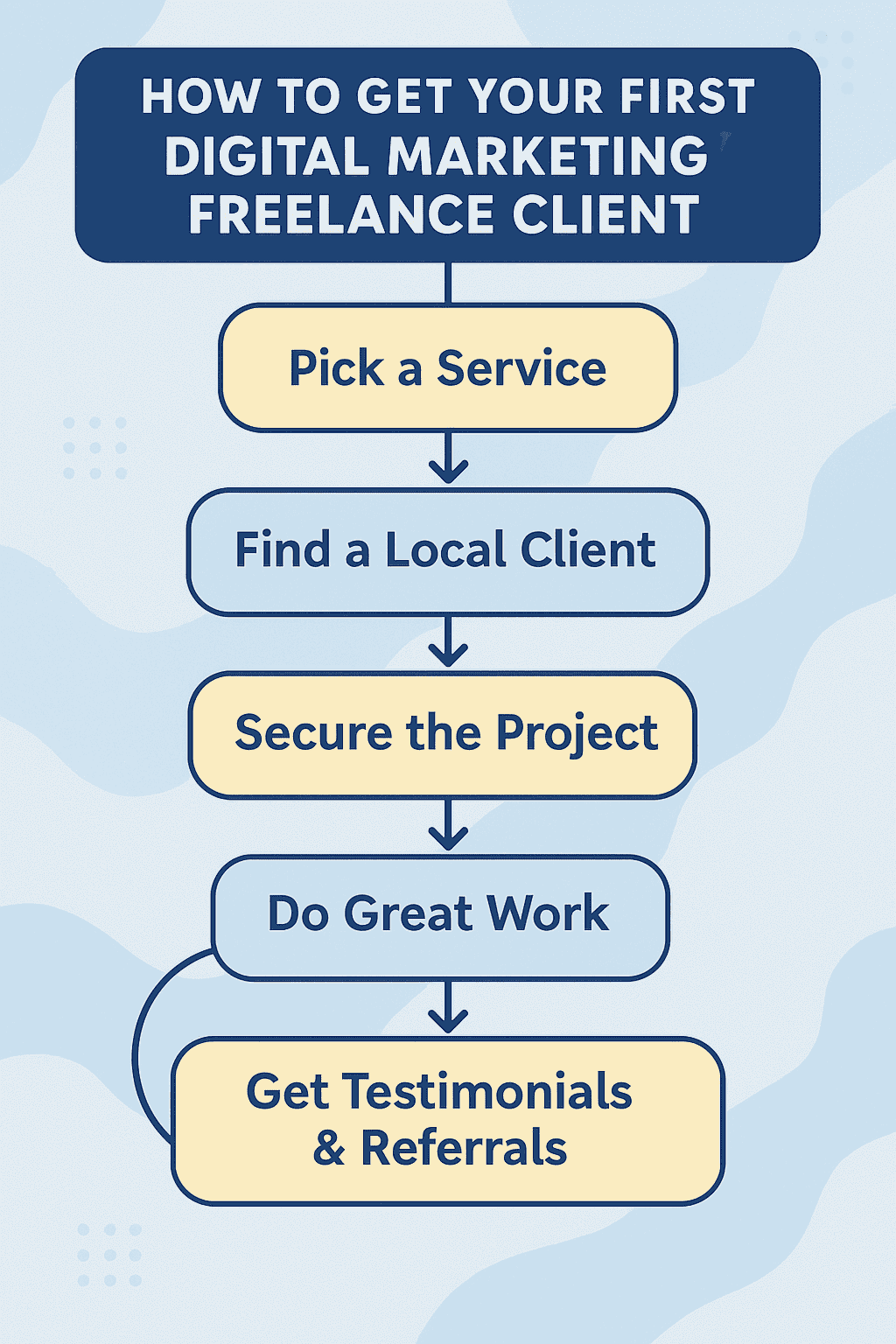How to Get Your First Freelance Digital Marketing Client
You don’t need another certificate. You need one client.
Jump Ahead to Learn:
Too busy to read? Listen to the podcast summary. 5 minutes
Introduction
You don’t become a marketer by studying digital marketing strategy. You become one by doing it.
You can write a caption, build a content calendar, write an email campaign, or maybe even set up a basic ad campaign. But here’s the real test: can you convince someone to pay you to do it?
For many early-stage digital marketers, landing that first freelance client isn’t about skill, it’s about confidence and clarity. It’s not about being the best, it’s all about starting.
This guide walks you through how to get your first freelance client without relying on Fiverr, Upwork, or mass job boards. Instead, you’ll focus on leveraging what you already know, who you already know, and how to turn one successful project into long-term momentum.
You Don’t Need 100 Clients. You Just Need One
There’s a myth that you need to have a stacked portfolio, personal website, testimonials, and a perfect offer to get started. The truth? Most businesses don’t need a perfect freelancer, they need someone who can help them build an online presence right now.
You might feel like you're not ready. You might even wonder, who would trust me with their marketing?
But here’s what separates action-takers from procrastinators: the willingness to try before you feel fully qualified. You might not be a social media manager or great at content marketing yet, but if you don't get started, you never will.
“You will never feel fully ready. Every new project teaches you something. That hands-on experience is just as valuable as any paycheck, sometimes even more.”
Your first client is more than a gig. It’s proof of concept. And it opens doors to referrals, case studies, and paid opportunities. Your future clients may know a little bit about content marketing, social media marketing, or even SEO. If they know something, they do not have time to execute it.
You just need to sign one client.
Freelance Digital Marketing: Define Your Offer
Choose a Specific, Valuable Service
Don’t start by offering “digital marketing services.” That’s vague and overwhelming. Potential clients don’t want generalists. They want clear solutions for their pain points.
Instead, choose one narrow service that solves a clear problem. Here are beginner-friendly but high-value examples:
Monthly Instagram content planning and creation
SEO audits for under-optimized local businesses
Google Business Profile setup and optimization
A 3-email welcome sequence for new subscribers
Landing page copywriting + layout recommendations
Lead generation and landing pages
The key is clarity. If someone asks what you do, your answer should be one sentence long. That sentence should include both the service and the result.
Example: “I help busy small business owners create clear and consistent content for their social media platforms.”
Use What You Know. Not What You Wish You Knew
You don’t need advanced marketing tools to get started. Build your services around tools you’ve already used:
Canva for visuals
Trello or Notion for project organization
Google Docs for briefs and collaboration
Meta Ads Manager for basic ad campaigns
Google Analytics or Search Console for audits
You don’t need fancy tech to deliver value. You need structure, consistency, and clarity.
How to Get Digital Marketing Clients Using Your Existing Network
Where to Start Looking
Your first client probably isn’t a stranger. It’s someone in your extended network. It will be a person or business that already trusts you or someone you know.
Places to look:
Friends and family with businesses or side hustles
Student clubs or local organizations
Freelancers or creators who need help growing
Professors or professionals in your academic network
Local cafés, gyms, or studios
This is about visibility. If people don’t know you’re offering services, they won’t ask. Make it clear to everyone you know that you are a digital marketer and that you’re available.
Outreach Template That Works
Here’s a message you can send by email, text, or DM:
Subject: Can I help you with your marketing? Hi [Name], I’m building my freelance digital marketing experience and wanted to offer a [service] to someone I know. No catch. I'm just hoping to learn, help out, and maybe get a testimonial if it’s useful. Let me know if you’d be open to a quick plan or phone call.
The key here isn’t selling. It’s offering value. Make it personal. Reference their business and keep it short.
Follow up a few days later if you don’t hear back.
Outreach with AI
If you want a different message for creating cold emails. You can easily use an AI LLM like ChatGPT. Use this prompt to get other options that you could customize to your liking.
Prompt:
I’m a freelance digital marketer reaching out to small business owners. Write a short, friendly outreach email offering a no-pressure consultation for [specific services, e.g., social media content and SEO audits]. The goal is to get them to reply. Keep the tone clear and professional.
How to Get Your First Freelance Marketing Client: Run It Like a Pro
Set Clear Expectations
Even if you're offering the work for free or at a discount, make the engagement feel real. Use a simple service agreement (even just in writing) that outlines:
The deliverables
Timeline
How you’ll communicate
What happens next
You can create this in Google Docs or use a free template from a platform like Bonsai or And.Co.
Deliver. Then Overdeliver.
Once the work starts, treat it like a paid job:
Show up on time
Ask smart questions
Present your work clearly
Deliver early when you can
Add a small bonus, like one extra post or a checklist of tips. These touches make you memorable and help clients refer you.
Turn That Project Into a Portfolio Asset
Create a Mini Case Study
You don’t need full analytics dashboards. You just need to show what you did and why it mattered. You can then add this case study to your digital marketing portfolio. If you don't have a digital marketing portfolio yet, don't worry, I created an easy-to-follow step-by-step guide.
Use this structure:
Client: What business or type of business was it?
Challenge: What weren’t they doing before?
Solution: What did you create or fix?
Result: What changed (even if it’s qualitative)?
Takeaway: What did you learn?
Write it in plain language and add visuals if you can (screenshots, sample posts, etc.).
Ask for a Testimonial
Don’t overthink it. Just ask:
“Hi [Name], I really appreciated the chance to work with you. Would you be open to writing a quick testimonial I can use in my portfolio or on LinkedIn?”
Pro Tip: Offer to write the testimonial and give them the draft so they can edit it and get it back to you. Remember these people are busy and they also don't usually have copywriting skills. Make it easy for them to help you.
Most will say yes. If not, you still gained valuable experience.
Publish It Somewhere
You don’t need a digital portfolio website to get started. Use:
Google Drive folder
Notion page
Simple free site builder (like Carrd or Wix)
Add the testimonial, project summary, and a brief explanation of your role. You now have a portfolio.
Pricing Your Services With Confidence
Once you’ve done a few projects (even unpaid), the question comes up: what do I charge?
Here’s a beginner’s framework:
Start Simple
For early-stage freelancers, pricing hourly often creates more stress than it solves. Instead, use flat-rate packages that reflect the value and not the time.
Example pricing for beginner services:
Instagram content (10 posts): $100–$200
SEO audit: $100–$250
Google Business Profile setup: $75–$150
Email welcome sequence: $150–$300
If you want to see what others are charging for similar services that have your experience level, check on Fiverr and Upwork.
Don’t Apologize for Charging
Even if you’re new, your knowledge has value. The business you’re helping doesn’t have time, tools, or know-how to do what you’re offering.
Don’t say, “Sorry, I know I’m just getting started...”
Instead, say, “This package is designed to deliver real value to your business, and I’ve priced it to reflect that.”
Be Transparent, But Professional
If you're still building your confidence, say so honestly:
“I’m early in my freelance career, so I’ve priced this project affordably while I build my portfolio. I’ll still treat it like a paid job and deliver real value.”
That shows both humility and professionalism.
Frequently Asked Questions (FAQs)
-
That’s normal, everyone starts somewhere. Be honest about where you’re at, set clear expectations, and treat it like a professional project. Focus on delivering value and learning in the process.
-
Once or twice is fine, especially if it’s a local business or nonprofit you believe in. But don’t do it forever. After your first project or two, start charging, even if it’s a small amount. It is important that people do not take advantage of you.
-
Not necessarily. A clear email or document outlining the scope, timeline, and deliverables is usually enough when you’re starting. As you grow, consider using simple contracts from tools like Bonsai or And.Co.
-
That can happen. The best move is to listen, ask questions, and see what you can fix. Don’t take it personally, it’s part of the learning process. Every tough situation makes you better.
-
Use it to your advantage. Explain what you did, the results you got, and what you learned. It shows initiative, problem-solving, and the kind of real-world experience most students don’t have.
Conclusion: Just get one Client
You don’t need a perfect portfolio or years of experience to get started in freelance digital marketing. You just need one project. One real client. One chance to show what you can do.
It won’t be flawless, and that’s okay. You’ll learn more from doing the work than you ever could from waiting until you feel ready.
Start small. Offer one clear service. Help one person. Then build from there.
The first step is the hardest. But it’s also the one that makes all the others possible.
Start by doing this:
Pick one service you can confidently offer.
Reach out to five businesses in your network or go to a networking event.
Run the project like it’s paid.
Document the results and ask for a testimonial.
Publish the project. Share the story. Keep going.
You have more knowledge than you think. What matters now is putting it into action.



